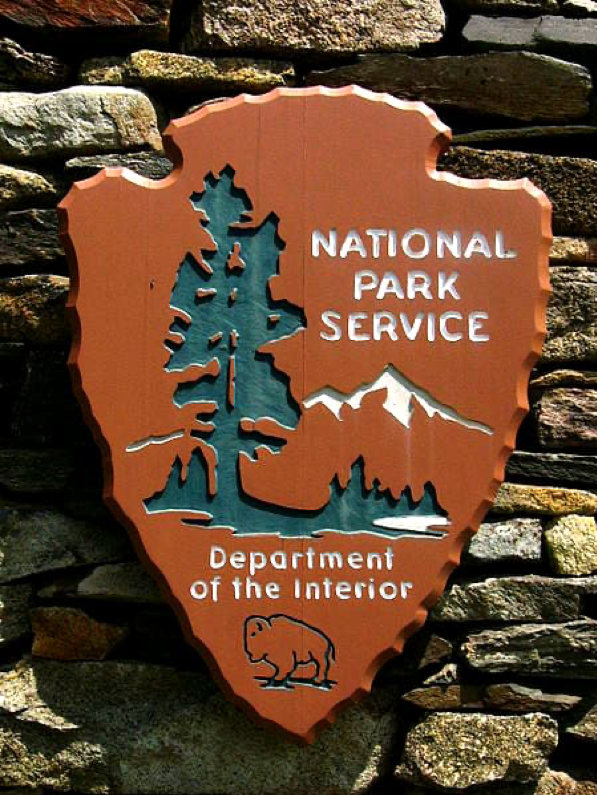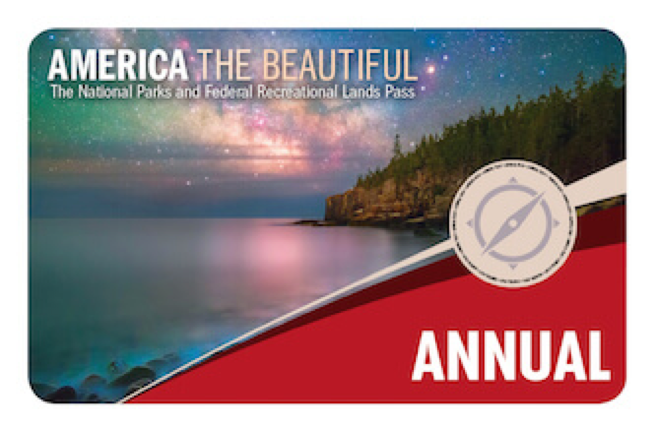Do you choose 1) half of a one-day ticket to Disneyland or 2) admission for you and a carload of family/friends to 2,000 places across the USA for a year?

Thinking of vacationing closer to home this summer? Going on a road trip? The US national parks are great destinations and stopovers. You can hang out in nature, enjoy outdoor sports, and learn about history, geology, and geography—what’s not to like? Glaciers to deserts, caves to coral reefs; they’re all yours for a daily fee or, even better, $80 a year. (And that’s per carload, not person.)

The America the Beautiful US National Parks Pass is valid for a year and admits a vehicle and up to four adults over 16 into each park for free. (Kids 15 and under are always free.) The pass has space for two signatures on the back, so you can share it with another person, and the two people don’t have to be related. You need to show photo ID every time you use the pass. Where the park charges an entry fee per person rather than a per vehicle fee, the pass usually covers up to four people. A pass covers entrance, standard amenity fees, and day use fees. Other activities (like camping, boat launch, swimming access, and guided tours) aren’t included.
The pass doesn’t just allow entrance to the 62 national parks. It also includes admission to over 2000 federally-owned recreation areas, wildlife refuges, forests, grasslands, and other areas maintained by the National Park Service, Bureau of Land Management, Bureau of Reclamation, the US Fish and Wildlife Service, the US Forest Service, and the US Army Corps of Engineers.
I couldn’t find a list of every place the pass is accepted, but it includes all national monuments, national forests, and wildlife refuges, in addition to the national parks. (The pass doesn’t include privately-owned sites and most state parks.)
There’s an even better deal if you’re 62 or older: US citizens and permanent residents over 62 can buy an annual senior pass for $20 or a lifetime pass for $80.
And certain groups are entitled to an annual pass for free:
- Every fourth-grade kid in America, plus all siblings under 16 and up to three adults
- Disabled U.S. citizens and permanent residents
- Members of the US military (Army, Navy, Air Force, Marines, Coast Guard, or Reserve and National Guard) and their dependents
- Volunteers with 250 service hours with federal agencies that participate in the Interagency Pass Program
Note: you can accumulate your 250 hours by volunteering on the federal recreation lands covered by the pass and managed by one or all of these agencies:
The senior, fourth-grader, disabled, and military passes may also provide a fifty-percent discount on some amenity fees charged for facilities and services.
How do you buy an annual pass?
- In person at a federal recreation site
- Online from the USGS; it sells the full range of passes (senior, disabled, military, volunteer) online and via mail
- Online from resellers like REI or USParkPass
Note: Resellers only sell the $80 annual pass. Some may add a service fee and the pass isn’t available for immediate download or printing. (You have to wait for a physical pass to be mailed; your receipt or an electronic scanned image of your pass aren’t valid for use.) Some (like REI) may also sell passes in-store; call ahead to check stock.
Is it worth buying an annual pass if you’re only visiting a national park or two?
Do the math. Every US national park charges a different rate (in winter, fees may be reduced $10). Many are free. Here are some examples:
Per vehicle charges
$35: Bryce Canyon (Utah); Glacier (Montana); Grand Canyon (Arizona); Grand Teton (Wyoming); Kings Canyon and Sequoia (California); Yellowstone (Idaho/Montana/Wyoming); Yosemite (California); Zion (Utah)
$30: Acadia (Maine); Arches (Utah); Big Bend (Texas); Canyonlands (Utah); Death Valley (California/Nevada); Everglades (Florida); Joshua Tree (California); Lassen Volcanic (California); Mount Rainier (Washington); Olympic (Washington); Pinnacles (California); Shenandoah (Virginia); Theodore Roosevelt (North Dakota)
$25: Badlands (South Dakota); Crater Lake (Oregon); Great Sand Dunes (Colorado); Haleakalā (Hawaii); Hawaii Volcanoes (Hawaii); Mesa Verde* (Colorado); Rocky Mountain (Colorado)
$20: Black Canyon of the Gunnison (Colorado); Capitol Reef (Utah); Petrified Forest (Arizona); Saguaro (Arizona)
Per person charges
$15: Carlsbad Caverns (New Mexico); Dry Tortugas (Florida)
$10: Denali (Alaska)
$7: Isle Royale (Michigan)
$5: Guadalupe Mountains (Texas)
$3: Gateway Arch (Missouri)
No entrance fee
Biscayne (Florida); Channel Islands (California); Congaree (South Carolina); Cuyahoga Valley (Ohio); Gates of the Arctic (Alaska); Glacier Bay (Alaska); Great Basin (Nevada); Great Smoky Mountains (North Carolina/Tennessee); Hot Springs (Arkansas); Katmai (Alaska); Kenai Fjords (Alaska); Kobuk Valley (Alaska); Lake Clark (Alaska); North Cascades (Washington); Redwood (California); Virgin Islands; Voyageurs (Minnesota); Wind Cave (South Dakota)
Note: Admission to all US national parks is free on certain days. Here are the 2020 dates:
January 20 (Martin Luther King Jr’s birthday)
April 18 (first day of National Parks Week)
August 25 (National Park Service’s birthday)
September 26 (National Public Lands Day)
November 11 (Veterans Day)
Conclusion? If you’re driving through the American Southwest, buying the pass is probably a good idea. Exploring Alaska? Individual admissions may cost less than an annual pass. A decent rule of thumb: if you’re visiting three sites, buy a pass.
That said, even if you’re only going to one park, why not buy a pass anyway and support a good cause? No other federal agency is as reliant on revenue and effort from visitors, volunteers, and donors. (That’s why if you’re into collecting patches or decals, you should buy them at the park or monument rather than on Amazon.)
Other perks of a pass? Many parks, like Yellowstone and Rocky Mountain, have a dedicated lane for pass holders, so you’ll save time. Plus, it may encourage you to visit more places; after all, you’ve already got the pass!
Finally, before you hit the road, check out the six-part PBS series “The National Parks: America’s Best Idea,” by Ken Burns. It will make you appreciate this incredible resource all the more.
Twist’s Take: At $80 or less, the America the Beautiful National Parks Pass is a bargain! It offers a year of free admission to 2000 federal recreation areas (including 62 national parks), can be shared by two people, and covers everyone in your vehicle.

